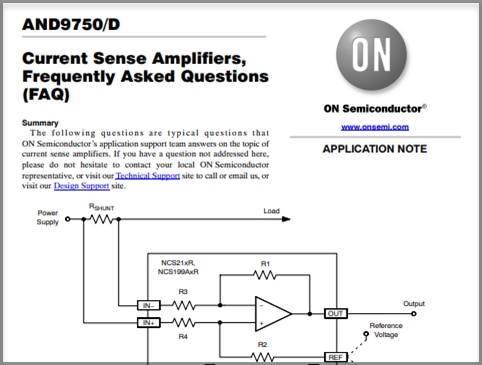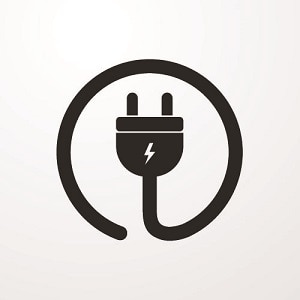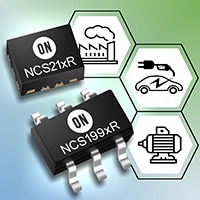The portfolio of Current Sense Amplifiers from onsemi includes a variety of voltage output, current-sense amplifiers, and current-shunt monitors that can measure the voltage across shunts at common−mode voltages from −0.3 V to 26 V, independent of the supply voltage. These products minimize BOM space and allow for system flexibility. They are low-cost, highly accurate, power-efficient, and offer minimal impact to battery life. Applications include Power Monitoring, Power Adapters, LED Power Supply, Over Current Protection, Closed Loop Feedback Circuits and Feedback Control Loops, Current Sensing (High-Side/Low-Side), External AC-DC Merchant Power Supply, Wireless Communications, and DSC among others. The portfolio also includes AEC-Q101 Qualified and PPAP Capable options specifically engineered and qualified for automotive industry applications.
What Are Current Sense Amplifiers?
A current sense amplifier is an integrated circuit differential amplifier that detects the voltage formed across a current shunt and outputs a voltage proportional to the measured current. Current-sense amplifiers give closed-loop feedback of system loads by monitoring current flow through a shunt resistor. Currents in the power rail can range from 1-20 A, necessitating a current-sense resistor in the 1-100 mΩ range.
In the face of 5-30 voltages, these amplifiers are designed to magnify a minimal "sense voltage" of 10-100 mV. These amplifiers are distinguished by their strong common-mode rejection ratio and DC accuracy.
How Does a Current Sense Amplifier Work?
A voltage drop known as Vsense is generated when load current flows through a shunt resistor on inputs. The internal instrumentation amplifier then amplifies Vsense. The current passing through the load determines the output voltage.
What Are the Most Significant Advantages of a Current Sense Amplifier?
Current-sense amplifiers are beneficial as they can do the following:
- Measure current in real-time
- Integrate matched resistive gain network allows you to monitor current properly
- Reduce the PCB size due to the incorporated gain resistance
What Are the Common Current Sense Amplifier Types?
- High-side amplifiers: Current is measured between the load and supply rail. The input pins' DC voltage can be substantially higher than the power supply.
- Low-side amplifiers: The input pins have a voltage that is near the ground.
- Unidirectional vs bidirectional: In some applications, current can flow in both directions into the load. A bidirectional amplifier can be used as a unidirectional current sense amplifier by setting the reference to one voltage rail.
How to Select the Appropriate Current Sense Amplifier for Your Design?
1) Determine the device's configuration requirements
- High-side configuration: Choose the current sense amplifier based on the application's maximum common-mode voltage and power source.
- Low-side configuration: Choose a current sense amplifier with less than 0 volts common-mode voltage.
2) Examine the stream flow's direction
- Consider whether the current in your application must flow in both directions when deciding between bidirectional and unidirectional current sensing.
3) Consider if exact measurements are required
- Voltage drop into the shunt resistor might be tiny depending on the current range to be measured and the shunt resistor employed. It is critical to examine the error associated with offset and accuracy gain to improve accuracy.
Product Family
Featured New Products
View All Products

NCS7041
Current Sense Amplifier, 80 V Common-Mode Voltage, Bidirectional
High voltage, high resolution, current sense amplifiers.
Related Resources

Application Note
Current Sense Amplifiers, Frequently Asked Questions (FAQ)
The following questions are typical questions that ON Semiconductor’s application support team answers on the topic of current sense amplifiers.
Videos
Related Articles
Blog

Current Sense Amplifier: Shunt Connections Part 1
Blog

Current Sense Amplifier: Shunt Connections Part 2
Blog

Current Sense Amplifier: Shunt Connections Part 3

